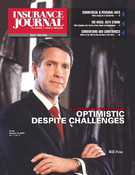Insurance agents in Connecticut and New York share similar views on insurance company performance overall. When the Professional Insurance Agents of Connecticut and New York State Inc. surveyed their respective members in 2003, these totally different groups of agents picked the same five areas where insurers do the best job. Likewise, both groups showed the least satisfaction with their companies on another five items. Moreover, the rank order and scores of the top five and bottom five items were virtually identical in each state.
Companies were selected based on the numbers of PIA members who represent them. While 11 companies appeared on both surveys, 20 additional companies were included on only one state’s survey. Each company was rated on 16 performance items. Scores ranged from 1 (lowest) to 5 (highest). The performance items reflect “must haves” that agents want in their company partners.
As a whole, agents rated companies’ performance the highest on the following items: coverage compares favorably; pays claims promptly; adjusts claims fairly; prompt, accurate policy issuance; and dedicated to the independent agency system. At the bottom, starting with those rated lowest, were: supports SEMCI; grants underwriting flexibility when warranted; supports agency marketing; pricing is competitive; and good technology support and training.
Some PIA members, who helped design the survey, were asked why they thought agents share the same overall perceptions. “I’m not surprised that companies scored high on being ‘dedicated to the independent agency system,'” said Shawn Viana, of Marshall & Sterling, Glenville, N.Y. “Over the past five to seven years, companies have come to realize the independent agent is their best distribution source. After the trials and tribulations with banks and direct writers, the only stable distributors were their independent agents.”
“Any company that purports to be dedicated to the independent agency system should be (a) dealing exclusively with independent agents and (b) creating a workflow that makes it easier and more efficient to do business with that company,” said Gary O’Brien of O’Brien Russo Quint Agency, Watertown, Conn. “Companies that also deal directly with the public are not dedicated to anyone but themselves. Those that insist on using proprietary software, creating the need for multiple data entry, are likewise dedicated to themselves only.”
Nick Fanelli of Raynard & Peirce Inc., North Canaan, Conn., said “agents are inclined to rate companies most favorably on some items that affect consumers directly—coverage and claims handling. On the other hand, agents are least satisfied with what I’ll call ‘back-room’ operations: SEMCI [single-entry, multiple-company interface], underwriting flexibility and technology support. These items impact agencies at the precise points where it interfaces most intensely with its companies.
“Agents are insurance people, not necessarily computer people,” Fanelli said. “A company can develop the best technology in the world, but without support, the computer is like dead weight tied around a producer’s ankles. No question we can work more efficiently and effectively, given decent technology. But too many companies fall down, either by not moving to Internet-based interface, or by handing agents complicated systems with little or no training and support.”
Technology is seen as a mixed blessing. Take policy issuance, long a sore point with agencies. “Increased reliance on automation has led to more accurate and faster policy issuance,” noted Marty Koles, PIANY treasurer, with a brokerage in Forest Hills, Queens. “Policies are issued by pushing the buttons to merge the data and attach the appropriate forms. To some degree, the same reasoning applies to why underwriting is more structured and flexibility reduced.”
“We are migrating to a system that lacks human underwriting judgment. More and more, companies are relying on computer-generated models to determine eligibility without any consideration for mitigating factors,” added O’Brien.
How do agents determine a company’s ratings? David Dickson, of Bailey Haskell & LaLonde, Oneida, N.Y., is convinced that the chief factor is how well the company knows, really knows, its agents. “If the company, from the CEO down, has gone to the trouble of getting to know its distribution system and against who it is competing in a given office, then this company is paying attention. This conveys an overall positive perception that will lead an agency to recommend the company to clients. It’s the confidence factor,” Dickson said.
PIACT’s and PIANY’s 2004 surveys are currently underway on the associations’ Web sites at www.piaonline.org/CT and www.piaonline.org/ NY.
Ellen D. Kiehl, Ph.D., CAE, is assistant executive director for government and industry affairs of the Professional Insurance Agents associations of New York State, New Jersey, Connecticut and New Hampshire Inc. She is responsible for government relations and insurance industry liaison programs for the four associations.
Was this article valuable?
Here are more articles you may enjoy.


 As Rates Rise, Majority of Homeowners Say Insurance Industry Is in Crisis: Survey
As Rates Rise, Majority of Homeowners Say Insurance Industry Is in Crisis: Survey  US Home Insurance Still Priced Too Low for Climate Risk, Says Swiss Re Chair
US Home Insurance Still Priced Too Low for Climate Risk, Says Swiss Re Chair  Coverage Needed: Hundreds of Thousands in SE Now in Flood Zones With New Maps
Coverage Needed: Hundreds of Thousands in SE Now in Flood Zones With New Maps  Changes at American Coastal Insurance After Florida OIR Action on ‘No-Fly List’
Changes at American Coastal Insurance After Florida OIR Action on ‘No-Fly List’ 


